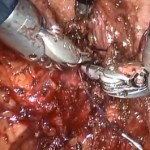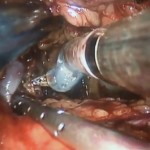Editorial: LESS versus laparoscopic nephroureterectomy: the winner is…
In this international multi-institutional study, Park et al. [1] have retrospectively collected and analysed data about 101 patients who underwent laparoendoscopic single-site (LESS) nephroureterectomy (NU) for upper urinary tract (UUT) urothelial carcinoma.
Nowadays, NU represents the standard of care for the surgical treatment of UUT urothelial carcinoma in the majority of patients [2]. Outcomes of such an intervention are strongly improved when lymph node dissection (LND) is performed according to a well-defined template [3].
In recent years, laparoscopy has become an important new approach to reduce the invasiveness of the surgical treatment of UUT urothelial carcinoma. In a multicentre Italian study Porpiglia et al. [4] showed that laparoscopic NU with open ureterectomy was a feasible and safe technique. Oncological results seemed to be similar to those of the traditional open approach, but the laparoscopic approach still has some disadvantages. First, patients who undergo a laparoscopic procedure receive LND with lower frequency. Moreover, the template during a laparoscopic procedure is rarely respected and the number of lymph nodes removed is often suboptimal [3]. Second, there is no consensus in the literature about the pathological stages that could potentially benefit from the bladder-cuff excision step of this procedure [5]. Bladder-cuff excision omission does not seem to undermine survival in patients with low-stage (pT1-2) disease, nevertheless confirmatory recurrence data are required before a NU without bladder-cuff excision may be considered as an option for this patient category.
The present paper shows that advances in surgical technology are being made, but it also underlines the fact that the above-mentioned disadvantages of NU are still under discussion, and these disadvantages are expanded when introducing a newer and challenging technique such as the LESS approach.
In the present study, different devices and instruments were used. Furthermore, the rate of LND reported was very low (27%), as the number of lymph nodes removed (approximately five). LND was often ‘formally’ performed, and no specific template was reported to be used. Bladder-cuff excision was not performed in 20% of cases and, when performed, the technique used was not clearly defined. With regard to oncological efficacy, the recurrence rate of 22% at 11 months is not sufficient to clarify if the LESS approach is oncologically effective [6].
In summary, there are evident limitations to the present paper; some are methodological, such as its retrospective nature and the non-homogeneous datasheets used to collect data, and some are technical and oncological. These limitations are justified by the fact that the technique is in its embryonic stages. Nevertheless, the authors deserve praise for having collected such a large number of cases for their study on LESS NU. Their paper underlines the fact that this technique is feasible and safe, and each surgeon who contributed by insisting on such a challenging and novel approach to NU should be congratulated for their efforts.
Now that the feasibility of the LESS NU technique has been demonstrated, the authors have the task of clarifying whether introducing a LESS approach would or would not compromise oncological outcomes. In any case, it is recommended that surgical oncological principles be respected when a new technique is introduced, especially when dealing with a high-risk cell-seeding tumour such as urothelial carcinoma.
Francesco Porpiglia and Riccardo Bertolo
Department of Clinical and Biological Sciences, San Luigi Hospital, Division of Urology, University of Turin, Orbassano-Turin, Italy
REFERENCES
- Park SY, Rha KH, Autorino R et al. Laparoendoscopic single-site nephroureterectomy for upper urinary tract urothelial carcinoma: outcomes of an international multi-institutional study of 101 patients. BJU Int 2013; 112: 610–615
- Rouprêt M, Zigeuner R, Palou J et al. European guidelines for the diagnosis and management of upper urinary tract urothelial cell carcinomas: 2011 update. Eur Urol 2011; 59: 584–594
- Roscigno M, Brausi M, Heidenreich A et al. Lymphadenectomy at the time of nephroureterectomy for upper tract urothelial cancer.Eur Urol 2011; 60: 776–783
- Porpiglia F, Celia A, Luciani L, Terrone C, Guazzoni G, Parma P. Laparoscopic radical nephroureterectomy: results of a multicentric italian study. J Endourol 2009; 23 (Suppl. 1): A109
- Lughezzani G, Sun M, Perrotte P et al. Should bladder cuff excision remain the standard of care at nephroureterectomy in patients with urothelial carcinoma of the renal pelvis? A population-based study. Eur Urol 2010; 57: 956–962
- Walton TJ, Novara G, Matsumoto K et al. Oncological outcomes after laparoscopic and open radical nephroureterectomy: results from an international cohort. BJU Int 2010; 108: 406–412




Ignore these editorial comments from a highly respected minimally invasive surgeon at your peril.